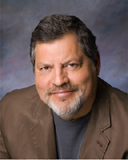Alejandro Moralez, MSW, LISW, (UNM Center for Development and Disability) Receives President's Award from NM Chapter of NASW
March 10, 2010

|
The Center for Development and Disability congratulates Alejandro Moralez, recipient of the President's award from the New Mexico chapter of the National Association of Social Workers (NASW). Alejandro accepted his award at the annual statewide conference of the NASW last week. He received a standing ovation from the almost 850 social workers attending the conference.
For many years Alejandro has donated his beautiful works of art that depict life in New Mexico to NASW. Raffle tickets are sold at each annual NASW conference. His picturesque donation this year was a 24" x 30" oil on canvas entitled Chamisa Trail; proceeds from each year's raffle go to the NASW student social work scholarship fund.
This year Alejandro's gift was able to provide even greater benefit. Prints of his painting were sold to benefit the family of "Baby Bella", a 3-week-old baby girl who has undergone surgery and is diagnosed with Biliary Artresia.
The CDD would like to acknowledge Alejandro's contributions and congratulate him once again on receiving this prestigious award.
About the CDD
 The Center for Development and Disability (CDD), established in 1990, is New Mexico's University Center for Excellence in Developmental Disabilities Education, Research and Service (previously known as a UAP). These centers are authorized by the Developmental Disabilities Assistance and Bill of Rights Act to build the capacities of states and communities to respond to the needs of individuals with developmental disabilities and their families. The Center for Development and Disability (CDD) is one organization in the national network of University Centers for Excellence in Developmental Disabilities Research, Education and Service. The network is coordinated by and receives core funding from the Administration on Developmental Disabilities (ADD). Funding for other programs and projects is obtained through state contracts, federal grants and private funding. There are 67 centers located in every state and territory, which function as a national network of programs.
The Center for Development and Disability (CDD), established in 1990, is New Mexico's University Center for Excellence in Developmental Disabilities Education, Research and Service (previously known as a UAP). These centers are authorized by the Developmental Disabilities Assistance and Bill of Rights Act to build the capacities of states and communities to respond to the needs of individuals with developmental disabilities and their families. The Center for Development and Disability (CDD) is one organization in the national network of University Centers for Excellence in Developmental Disabilities Research, Education and Service. The network is coordinated by and receives core funding from the Administration on Developmental Disabilities (ADD). Funding for other programs and projects is obtained through state contracts, federal grants and private funding. There are 67 centers located in every state and territory, which function as a national network of programs.







